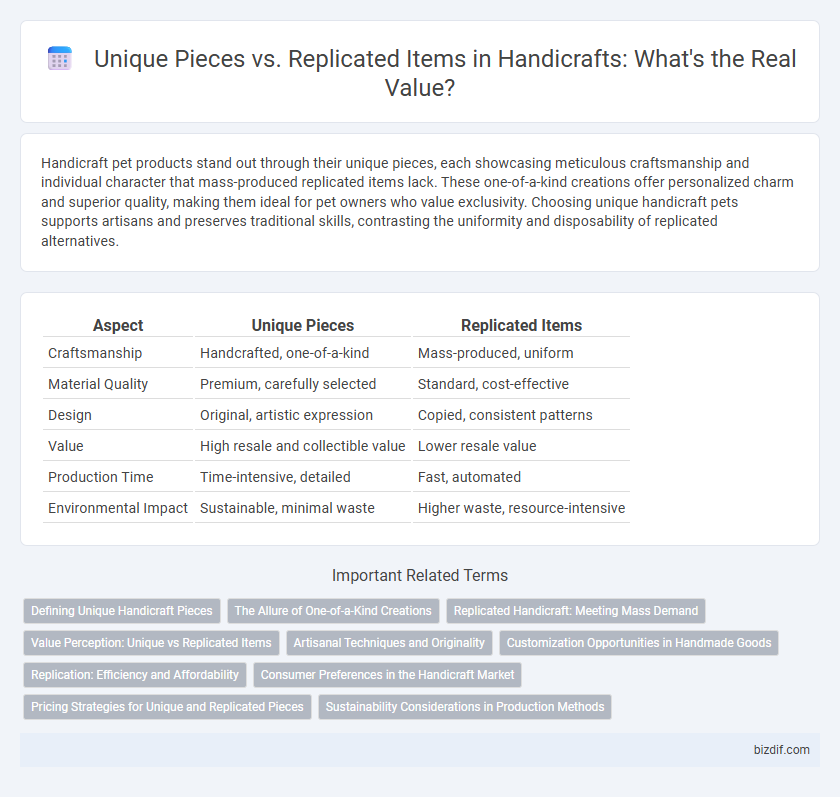Handicraft pet products stand out through their unique pieces, each showcasing meticulous craftsmanship and individual character that mass-produced replicated items lack. These one-of-a-kind creations offer personalized charm and superior quality, making them ideal for pet owners who value exclusivity. Choosing unique handicraft pets supports artisans and preserves traditional skills, contrasting the uniformity and disposability of replicated alternatives.
Table of Comparison
| Aspect | Unique Pieces | Replicated Items |
|---|---|---|
| Craftsmanship | Handcrafted, one-of-a-kind | Mass-produced, uniform |
| Material Quality | Premium, carefully selected | Standard, cost-effective |
| Design | Original, artistic expression | Copied, consistent patterns |
| Value | High resale and collectible value | Lower resale value |
| Production Time | Time-intensive, detailed | Fast, automated |
| Environmental Impact | Sustainable, minimal waste | Higher waste, resource-intensive |
Defining Unique Handicraft Pieces
Unique handicraft pieces are individually crafted items that showcase distinct artistic expression and cultural heritage, often created using traditional techniques passed down through generations. These one-of-a-kind creations embody originality, intricate details, and personal craftsmanship that cannot be duplicated or mass-produced. Their exclusivity and authenticity make them highly valued compared to replicated items, which lack the personalized touch and unique imperfections inherent in handmade works.
The Allure of One-of-a-Kind Creations
One-of-a-kind handicraft pieces captivate collectors and enthusiasts by embodying individuality and artistic expression that mass-produced replicated items lack. These unique creations often display intricate craftsmanship, cultural heritage, and personal stories, enhancing their value and emotional connection. The rarity and authenticity of handcrafted artifacts drive their appeal, making them treasured symbols of creativity and tradition.
Replicated Handicraft: Meeting Mass Demand
Replicated handicraft plays a crucial role in meeting the high demand for decorative and functional items by enabling mass production while maintaining traditional design elements. Factories use molds and standardized techniques to produce multiple copies of artisanal styles, making these products affordable and accessible globally. Although lacking the individuality of unique pieces, replicated handicrafts preserve cultural aesthetics and support widespread market availability.
Value Perception: Unique vs Replicated Items
Handicraft unique pieces carry a higher value perception due to their exclusivity, craftsmanship, and authenticity, making them more desirable to collectors and connoisseurs. Replicated items lack the individual artistry and historical significance, often perceived as mass-produced with lower emotional and monetary worth. Market demand favors unique handicraft items because they symbolize originality and cultural heritage, enhancing their overall value.
Artisanal Techniques and Originality
Handicraft thrives on artisanal techniques that emphasize originality, resulting in unique pieces that embody cultural heritage and individual creativity. Each handcrafted item reflects the artisan's skill and personal touch, distinguishing it from replicated items produced through mass manufacturing processes. The value of unique pieces lies in their authenticity, intricate craftsmanship, and the storytelling embedded within every detail.
Customization Opportunities in Handmade Goods
Handmade goods offer unparalleled customization opportunities, allowing artisans to tailor each piece to individual preferences, making every item a unique expression of creativity. Unlike replicated items, which are mass-produced with standardized designs, handcrafted products emphasize personal details, skilled craftsmanship, and exclusive materials. This level of customization not only enhances the emotional value but also supports sustainable practices by prioritizing quality over quantity.
Replication: Efficiency and Affordability
Replication in handicraft enhances efficiency by streamlining production processes, allowing for consistent quality across multiple items and reducing time spent on each piece. This approach significantly lowers costs, making handcrafted items more affordable and accessible to a broader market while maintaining essential artistic details. Businesses benefit from replication by balancing craftsmanship with scalable output, meeting consumer demand without compromising value.
Consumer Preferences in the Handicraft Market
Consumer preferences in the handicraft market increasingly favor unique pieces over replicated items due to their inherent authenticity and cultural value. Unique handicrafts are often perceived as more meaningful and exclusive, reflecting individual craftsmanship and creativity absent in mass-produced replicas. This preference drives demand for artisan-made products that support traditional skills and sustainable practices, shaping market trends and pricing structures.
Pricing Strategies for Unique and Replicated Pieces
Handicraft pricing strategies for unique pieces emphasize exclusivity and craftsmanship, often commanding higher prices due to their rarity and detailed artistry. Replicated items, produced in larger quantities, typically follow competitive pricing models that reflect economies of scale and accessibility. Balancing perceived value and production costs is crucial in differentiating pricing for one-of-a-kind creations versus mass-produced handicrafts.
Sustainability Considerations in Production Methods
Unique handicraft pieces minimize environmental impact by utilizing local, natural materials and traditional techniques that reduce waste and energy consumption. Replicated items often rely on mass production methods, which can lead to higher carbon footprints and resource depletion due to mechanized processes and synthetic materials. Sustainable production prioritizes artisanal craftsmanship with eco-friendly sourcing to support biodiversity and cultural heritage while lowering ecological emissions.
Unique Pieces vs Replicated Items Infographic

 bizdif.com
bizdif.com